Important SEO Statistics, Facts, and Trends for 2024

Today’s search engines began with the creation of Archie in 1990. Archie was a simple FTP site with a downloadable directory of listings. Later advancements in web technologies, particularly site crawling and indexing, led to the exponential expansion and popularity of search engines.
In fact, over the years search engines became so popular that they created a new industry known as Search Engine Optimization (SEO). SEO is so impactful that it’s impossible to share about it without a number of facts and statistics. To that end, we are providing a list of the most relevant and up-to-date information.
Interesting SEO (Search Engine Optimization) Statistics
- Search engines drive 300% more traffic to sites than social media.
- 64% of marketers say that SEO is one of their primary marketing efforts.
- The number one on-page SEO factor is content.
- Core Web Vitals will become important page experience signals.
- Page loading speed remains among the top ranking factors.
- Keyword in the Title Tag remains an important on-page SEO signal.
- Backlinks account for 30% of an overall page score in Google.
- Long-form content generates on average 10x more backlinks
- Optimization for mobile is one of the most used SEO tactics.
- Posts with videos earn more backlinks and see a 157% boost in search traffic.
- 30% of all online searches are related to location.
Below, you will find a list of 58 of the most important and interesting SEO statistics. We’ve organized them into seven categories to easily explain the entire SEO industry and related trends.
General SEO statistics
Typing in the exact website address that you are seeking in a browser bar seems like a thing of the past. More and more people use search engines on a daily basis to access their favorite websites and find online content. Because of this, many marketers see the value in SEO. Let’s browse the stats that illustrate the importance of SEO.
1. Search engines drive 300% more traffic to sites than social media.
Search is the #1 driver of traffic to content sites, beating social media by more than 300%. If you want to get more traffic to your website or your new blog, you need to appear in Google search results so that users can find you easily.
(Source: Imforza)
2. SEO leads convert 9 times more than outbound leads.
SEO leads have a 14.6% close rate, while outbound leads (such as direct mail or print advertising) have a 1.7% close rate.
(Source: Imforza)
3. SEO leads have the highest conversion rate at 14.6%
Search engines are the primary resource of high-quality leads for many businesses. Leads coming from SEO have a 14.6% conversion rate.
(Source: MarijuanaSEO)
4. Marketers favor organic SEO over paid SEO because it’s 5.66 times better.
Long-term SEO strategy is bound to deliver better results than any paid SEO effort. Organic SEO is 5.66 times more effective than paid SEO.
(Source: Hubspot)
5. Only 25% of users go past the first search engine result page.
It’s essential for many websites to rank on the first search engine result page. 75% of users do not scroll past the first page of search results.
(Source: MarijuanaSEO)
6. For 64% of marketers, SEO is one of their primary digital marketing efforts.
Marketers understand the value of a long-term SEO strategy. SEO has become a standard in the marketing mix, shoulder to shoulder with content, email, and social media marketing. About 64% of marketers actively invest time in search engine optimization (SEO).
(Source: Hubspot)
Factors affecting page ranking
Over the years, search engines have evolved and improved. As a reflection of that, crawling, indexing, and ranking algorithms have become very sophisticated. Search engines use various factors when cross-referencing a website to a user inquiry to deliver the most relevant results. Let’s view the most important factors affecting page ranking on search engine result pages.
7. Google takes into account over 200 factors when ranking websites.
Google has a very comprehensive ranking algorithm. Over the years, it has been revamped and updated a dozen times. Today, Google uses over 200 factors in its algorithm for ranking websites.
(Source: Backlinko)
8. The number one on-page SEO factor is content.
Every SEO ranking factor is important such as page speed, quality backlinks, social signals, and so on. However, content is still the king. It is the first most important on-page SEO factor.
(Source: Moz.com)
9. Web Vitals Metrics are essential for a great user experience on-site.
Web Vitals Metrics tell SEOs whether a website is healthy or not in terms of SEO. Web Vitals Metrics include:
- Largest Contentful Paint (LCP);
- First Input Delay (FID);
- Cumulative Layout Shift (CLS); and
- Defining the Core Web Vitals metrics thresholds.
(Source: Web.dev)
10. Core Web Vitals will become important page experience signals.
Google continues to work on optimizing and delivering the best user experience. Starting in May 2021, Core Web vitals will be included in page experience signals, together with existing search signals including mobile-friendliness, safe-browsing, HTTPS-security, and intrusive interstitial guidelines.
(Source: Google)
11. Quality backlinks and RankBrain are the second most important ranking factor.
The content might be the king, but other factors help it to rule the SEO domain. They also have a say in which page will be ranked on the first search engine result page. Top factors for Google’s search results, after content, are links and RankBrain.
(Source: Search Engine Watch)
12. There are seven essential elements that make a page well-optimized for search engines.
According to MOZ, there are seven elements of a well optimized page:
- Unique Value;
- Phenomenal UX;
- Keyword–Targeted;
- Built to be Shared through Social Networks;
- Multi-Device Ready;
- Crawler/Bot Accessible; and
- Authorship, Meta Data, Schema, and Rich Snippets.
(Source: MOZ)
13. Page loading speed remains among the top ranking factors.
In the era of mobile phones and short attention spans, page loading speed plays a crucial role in user experience. That’s why it’s a very important SEO factor. Pages on websites that load quickly rank significantly higher than pages on sites that load slowly.
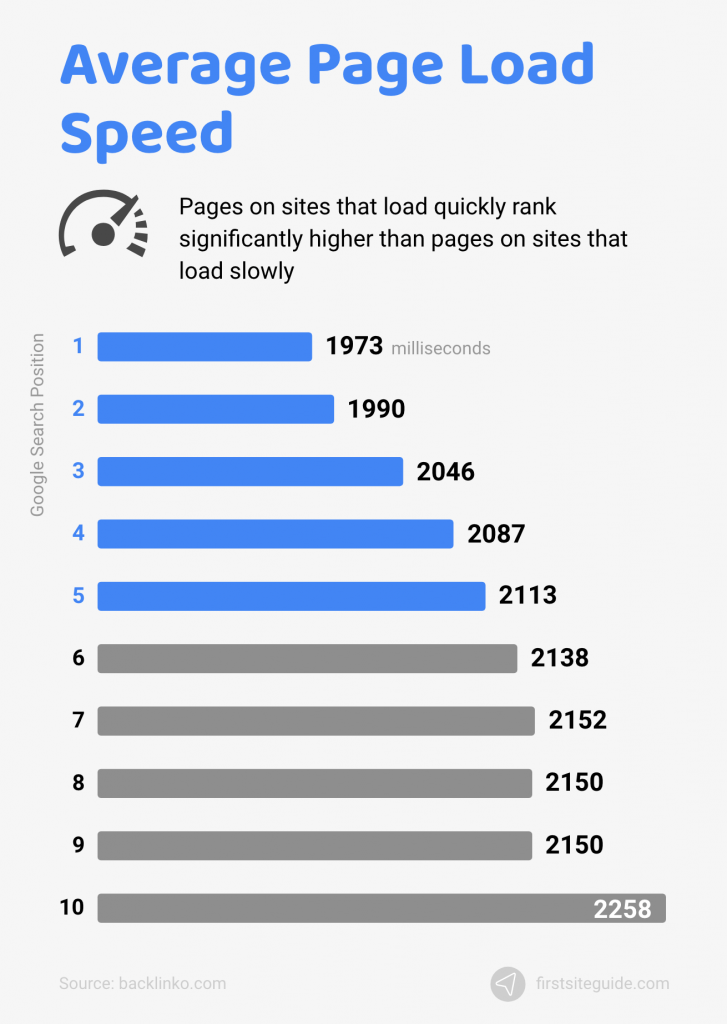
(Source: Backlinko)
14. 60% of pages on the first SERP are at least 3 years old.
It appears old pages rank better than the new pages. Old pages perform better than the new ones, at least in terms of ranking on the first search engine result page. Nearly 60% of the pages ranking in the top 10 Google results are 3 or more years old.
(Source: Ahrefs)
15. Longer content receives 68.1% more engagement on Twitter and 22.6% more on Facebook.
On average, longer content received 68.1% more engagement on Twitter (Tweets) and 22.6% more on Facebook (Likes). We know that social signals are a major ranking factor and since longer content drives more engagement, web pages with a lengthier content rank higher.
(Source: Sweor)
16. Experts set high criteria for a web page to be ideal for search engines.
An ideal web page should do all of the following:
- Be hyper-relevant to a specific topic (usually a product or single object);
- Provide unique content about a given subject;
- Link back to its category page;
- Link back to its subcategory page (If applicable); and
- Link back to its homepage.
(Source: MOZ)
17. Top-ranked web pages have a click-through rate of 18.2%.
Click-through rate correlates with the position of a site on the Search Engine Result Page. The web pages at the bottom of the search engine result page have a click-through rate of 1.52%, while the ones ranked first have a CTR of 18.2%.
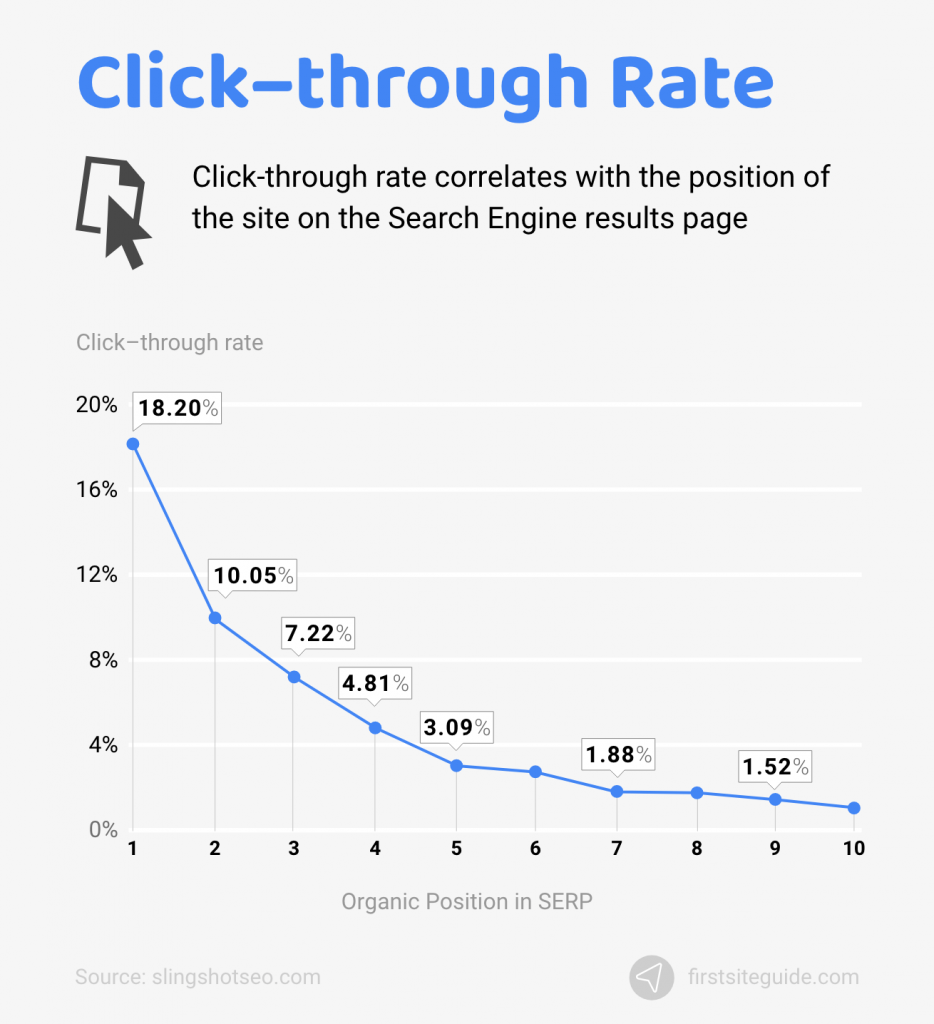
(Source: SlingshotSEO)
Keyword statistics
Keywords are very important ranking factors. Simply put, they describe the content on your site pages. Keywords are the inquiries that your target visitors type into search engines when looking for information, products, and services online.
However, after every major search engine update, the rules of the keyword game change. Let’s see what the rules are now and examine the most important keyword statistics.
18. Keyword in the Title Tag is still one of the best SEO practices.
Is the Title Tag still the best way to place your target keyword? It is not as essential as it was in the past. However, a keyword in the Title Tag remains an important on-page SEO signal, and experts continue to advise content creators to stick to it as one of the SEO rules of thumb.
(Source: Backlinko)
19. Results on the first Google SERP contain up to 85% of the keyword that is an exact or partial match of the inquiry.
It’s easy to check whether the keyword in the Title Tag is still a dominant SEO practice. Most Title Tags on Google’s first SERP contain 65% to 85% of keywords that are a partial or exact match of that specific user inquiry.
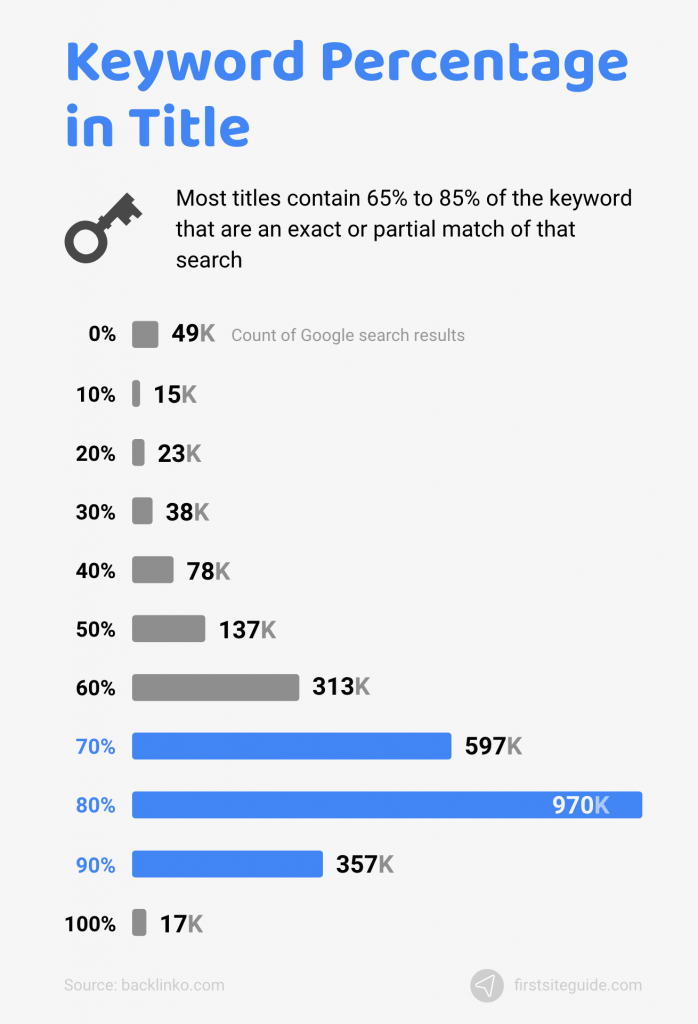
(Source: Backlinko)
However, in a recent interview, Google’s John Mueller said that Google is using BERT, a machine learning tool that has been established to help the ranking algorithms understand the content better. He also said that Google is moving in the direction of making exact match keywords less important.
(Source: Search Engine Journal)
20. 79% and 47% of the top-ranked keywords rank differently on mobile and desktop, respectively.
A keyword doesn’t necessarily have to rank the same in both mobile and desktop searches. In fact, the great majority doesn’t. 79% of keywords and 47% of keywords in positions 1-20 rank differently on mobile and desktop.
(Source: BrightEdge)
21. The content length of web pages ranked in the top 10 results for any keyword is at least 2,000 words.
Targeting the right keywords and using them to drive content strategy is one piece of the puzzle. Content length is another piece. The serpIQ analyzed the top 10 search results for over 20,000 keywords and noticed a pattern. The average content length for a web page that ranks in the top 10 results for any keyword on Google has at least 2,000 words.
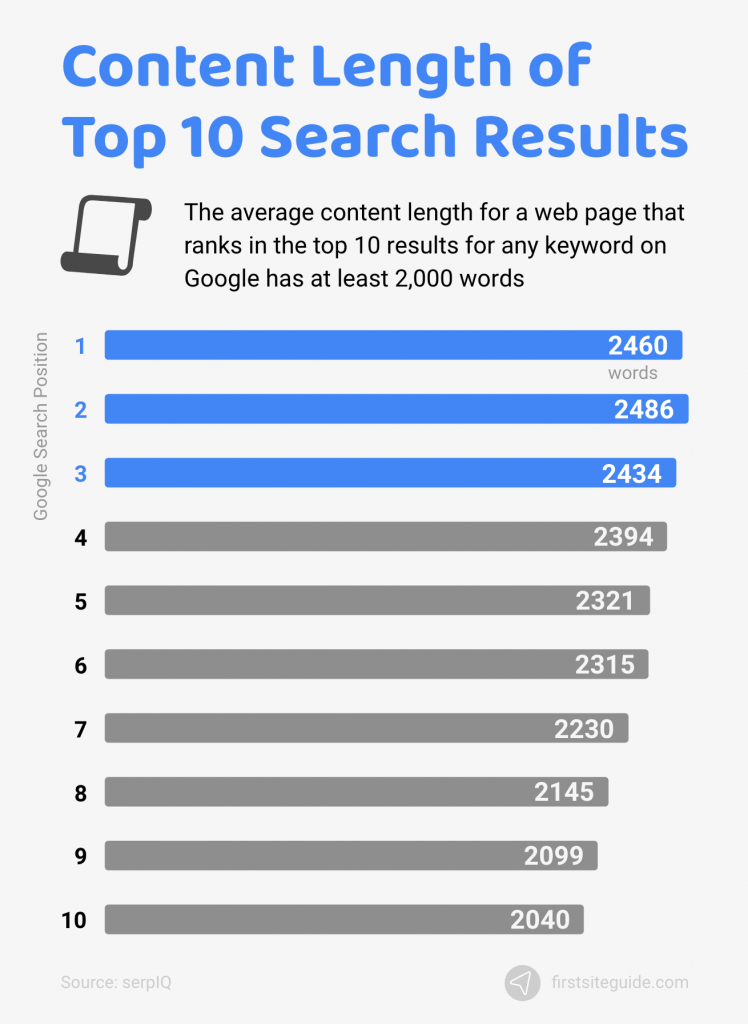
(Source: Sweor)
22. It is important to insert keywords into seven web page elements.
Using keywords in Title Tag is only one on-page SEO practice. For a page to rank better, you have to use keywords in the following elements:
- Page title;
- Headline;
- Body text;
- URL;
- Images and image alt attributes;
- Internal and external links;
- Meta description; and
- Meta keywords.
(Source: Backlinko)
23. Placing a keyword into the Title Tag doesn’t guarantee a high rank on the 1st SERP.
While keywords play an essential role in an SEO strategy of any scale, it appears that placing keywords into the title tag doesn’t promise the top position. A keyword-optimized title tag doesn’t appear to correlate with higher rankings on the first page.
(Source: Backlinko)
24. Keyword-optimized H1s have zero correlation with higher rankings in the SERP.
Placing keywords in H1s has been a rule of thumb for years, but the latest findings show that keyword-matched H1s have essentially no relationship with higher Google rankings.
(Source: Backlinko)
Link statistics
Backlinks remain one of the strongest ranking signals for every major search engine, including Google. That’s why every SEO expert dreams about getting a do-follow link on a website with a domain authority of 90 or above. Check out these stats to confirm the importance of backlinks.
25. Top results on Google’s first SERP have 3.8 times more backlinks than those below them.
The more backlinks, the better, but is this a fact or just an empty promise? Pages with lots of backlinks rank above pages that don’t have as many backlinks. In fact, the #1 result on Google has an average of 3.8x more backlinks than positions #2 – 10.
(Source: Backlinko)
26. High-quality backlinks account for 30% of your overall page score in Google.
Google uses their page score to assess how important and credible a web page is. Backlinks are major factor when it comes to the page score. In fact, they account for 30% of an overall page score in Google.
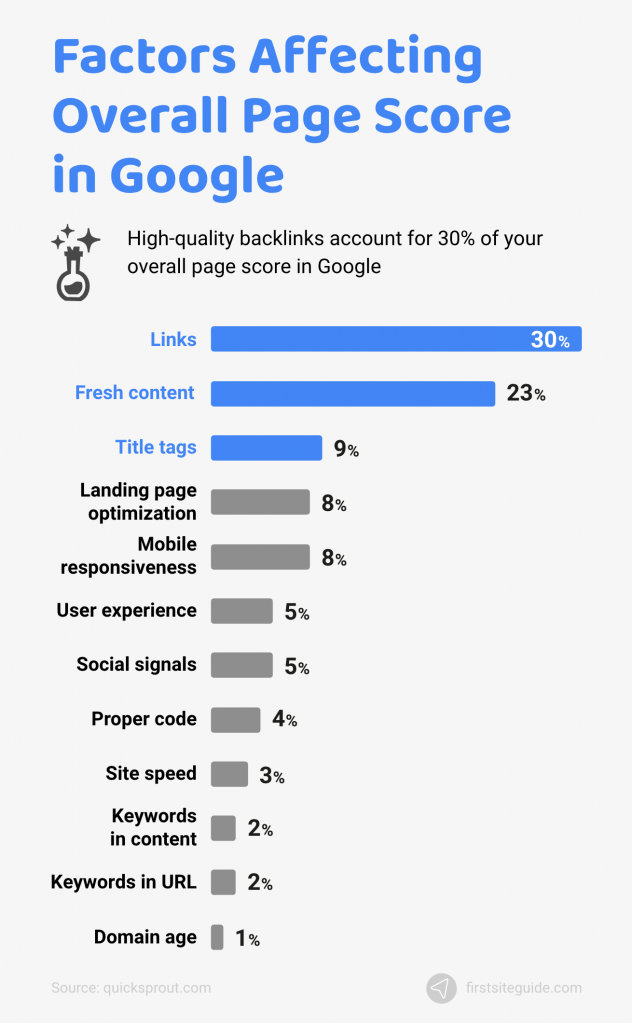
(Source: QuickSprout)
27. The more backlinks a page has, the better it will rank in the SERPs.
The quality of backlinks matters but so does the quantity. A high number of backlinks sends a strong signal to Google that the page is important. Pages with the highest number of total backlinks tend to rank best on Google.
(Source: Backlinko)
28. Pages in the first position in SERPs have 35,000+ backlinks.
How many backlinks are enough? The latest backlinks analysis reports tell us that pages ranking #1 often have 35,000 backlinks. In some cases, they have even more.
(Source: Backlinko)
29. 95% of all pages online have zero backlinks.
While some web pages have tens of thousands of backlinks, others have none. Approximately 95% of all pages have zero backlinks.
(Source: Backlinko)
30. Lengthier content is 10x better for backlink building strategy than short blog posts.
The debate about whether lengthier content or short posts are better to base a backlink strategy on is ongoing. However, it appears we now have conclusive evidence to end the debate. Long-form content generates on average 10x more backlinks than short blog posts.
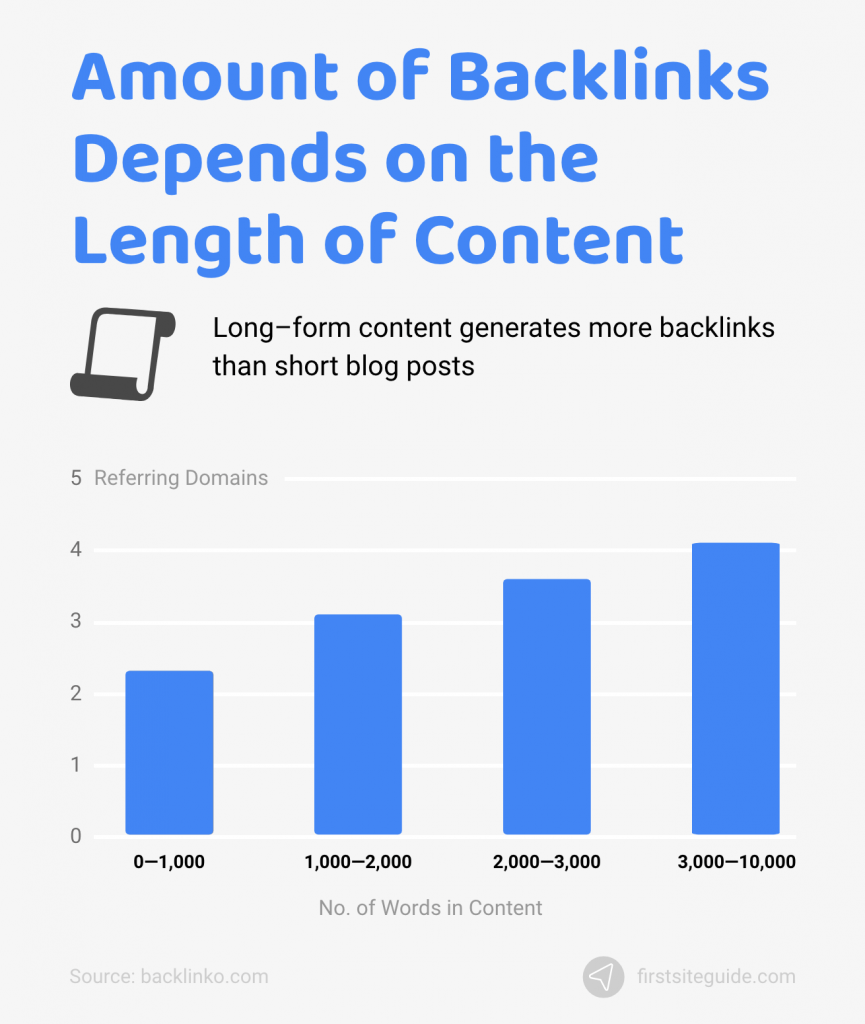
(Source: Backlinko)
31. URLs on Google’s 1st page are between 40 and 100 characters long.
It’s important to take note of URL length too. After thorough analysis, researchers identified certain patterns when it comes to URL length and ranking position. All of the URLs found on Google’s first page are 40 to 100 characters long.
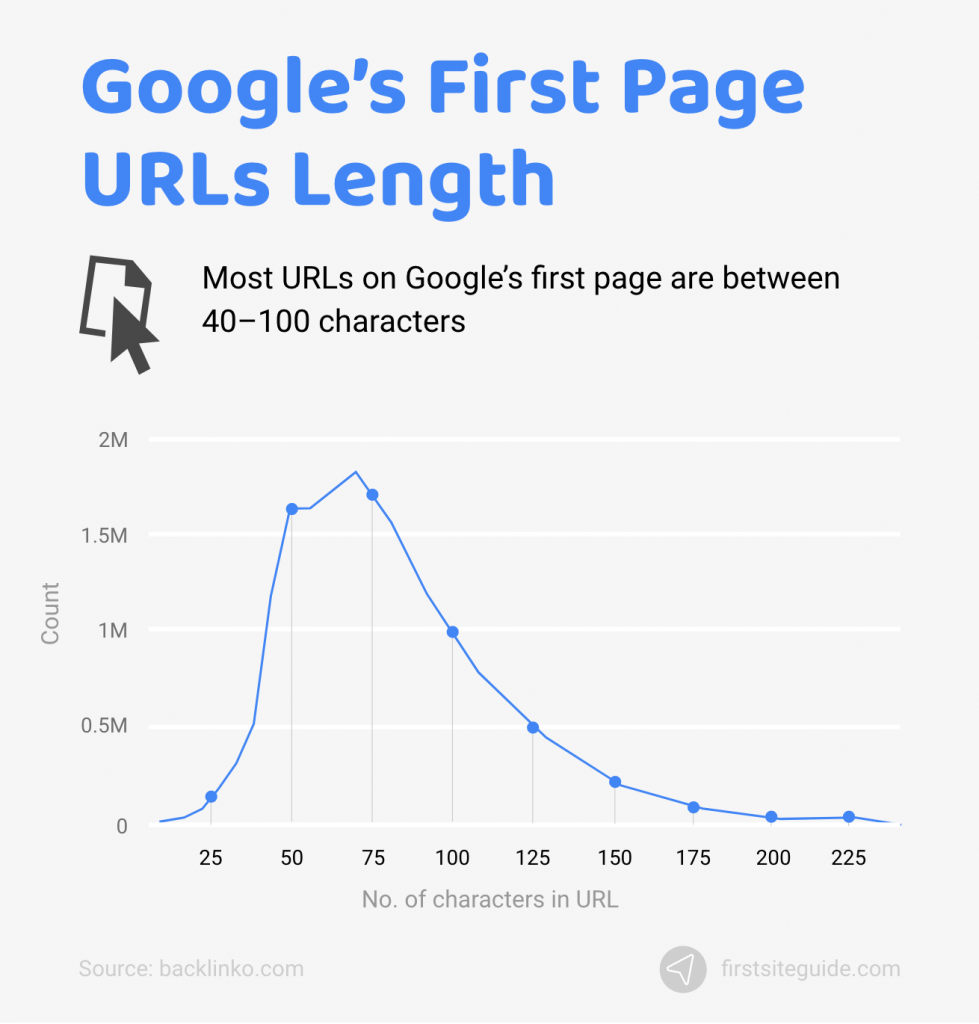
(Source: Backlinko)
32. #1 results in Google SERPS have approximately 279 referring domains.
The number of quality backlinks is as significant a factor as the number of referring domains the backlinks are placed on. An industry study of 1 million Google search results shows that the number of referring domains is one of the most important ranking factors in Google’s algorithm.
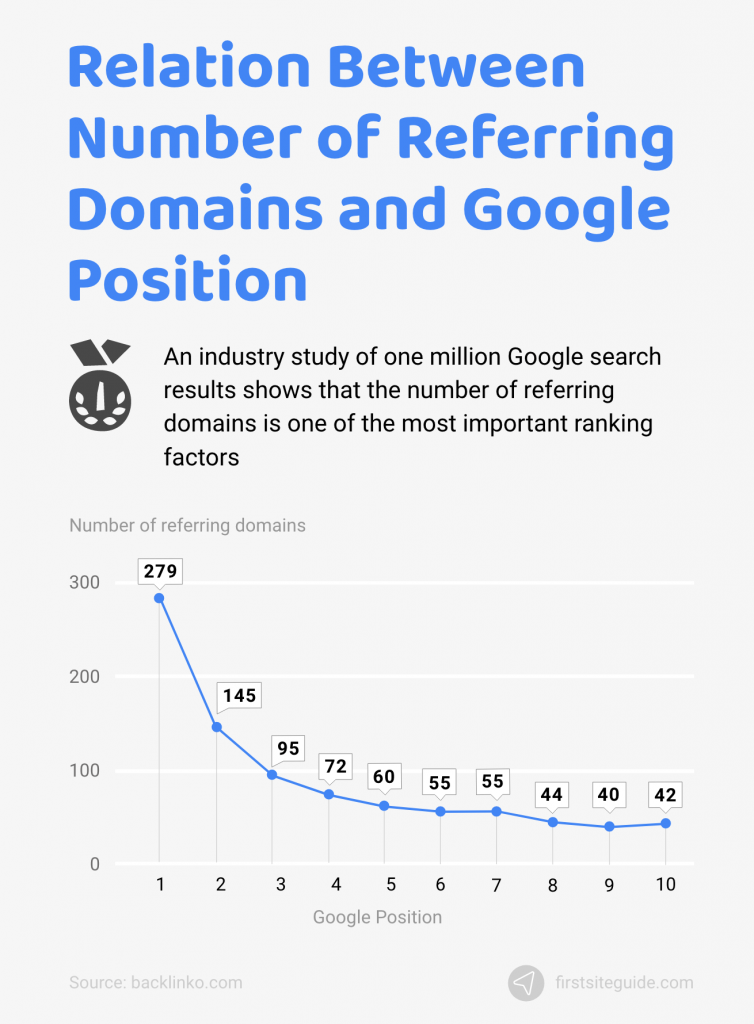
(Source: Backlinko)
33. Domain authority is a critical ranking factor.
Domain authority is still one of the major ranking factors. If you apply two same SEO strategies on a page hosted on a site with an authoritative domain and one on a domain with less authority, the results will differ. The page on an authoritative domain will always rank higher.
(Source: Backlinko)
34. Overall link authority determines the site’s rank position in the SERPs.
Comprehensive research revealed the link between Domain Authority and the position of a website in the SERPs. Domain Authority data shows that a site’s overall link authority (as measured by Ahrefs Domain Rating) strongly correlates with higher rankings.
(Source: Backlinko)
Mobile SEO statistics
Optimizing website design and content for mobile visitors is paramount for anyone who wants to gain online visibility and extend their reach. Mobile SEO is a subcategory of SEO focused on optimizing web page content exclusively for mobile users. Scroll down to discover mobile SEO facts and see the latest SEO stats from the industry.
35. News from Google: page experience signals for ranking only come into play in mobile search.
Google support for Webmasters indicates that page experience signals for ranking only apply to mobile search. Scores for mobile and desktop are different. In mobile SEO, it’s best to use the mobile scores as a guide going forward.
(Source: Google)
36. Optimizing mobile performance is the best SEO method for improving site performance.
There are a number of things one can do to improve site performance. However, the best way is to do what the top marketers do – use technical SEO to optimize mobile performance.
(Source: HubSpot)
37. 3,400 marketers concur that mobile SEO is the most used SEO tactic.
There are dozens of SEO tactics available, but which SEO tactic is the most relevant in our day and age? According to data from over 3,400 marketers across the globe, optimization for mobile is one of the most used SEO tactics, along with Load Speed Optimization and Localization.
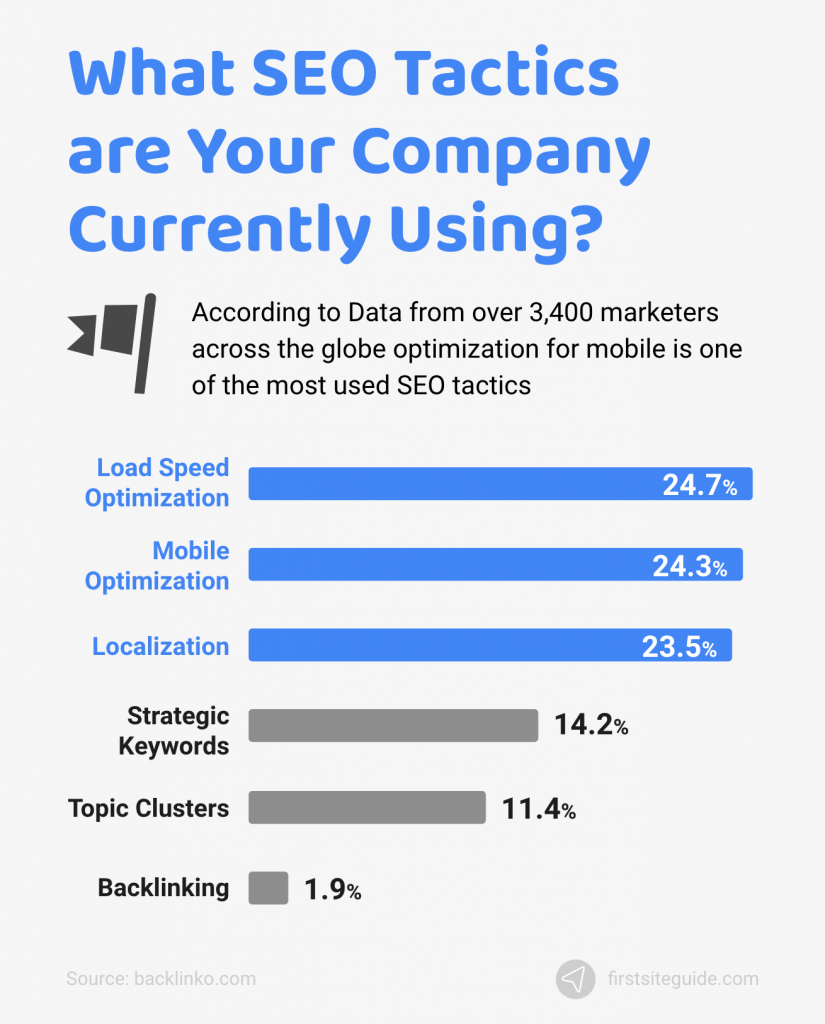
(Source: Hubspot)
38. 60% of mobile users contact businesses directly via search results.
More and more people are looking for actionable information online. Mobile SEO can help you to cater to the modern consumer’s needs. 60% of smartphone users have contacted a business directly using search results (e.g. “click to call” option).
(Source: Think with Google, 2019)
39. 87% of internet users in the U.S. use more than one device when going online.
Mobile SEO is more essential now than ever. According to the latest research, 87% of people who regularly use the internet in the US do it on more than just one device.
(Source: Think with Google, 2019)
40. Almost 25% of companies invest in mobile optimization as a top SEO tactic.
Businesses from various industries are jumping on board with mobile SEO. At the moment, almost 25% of companies of all sizes take mobile optimization as a top SEO priority and continuously invest in it.
(Source: HubSpot)
41. Dedicated mobile apps are becoming more important as 39% of mobile users prefer them.
Dedicated mobile apps are becoming increasingly popular among people who use the internet for online shopping. 39% of smartphone users are more likely to browse or shop a company or brand’s mobile app because it’s easier or faster to make a purchase.
(Source: Think with Google)
Video SEO statistics
Video is a huge thing in the world of SEO. It packs the most engagement potential and can be embedded anywhere. We can see videos on social media, blogs, and even embedded into forum posts. How does video perform in terms of ROI? What are Video SEO ranking factors? The answers to these questions are right below.
42. 52% of marketers say the video is the type of content with the best ROI.
Marketers leverage all types of content in their marketing mix. However, not all content performs well across all demographics. It appears that video content offers the best ROI, as 52% of marketers will confirm.
(Source: HubSpot)
43. 85% of Internet users in the US regularly interact with video content.
Video content is what consumers want to have access to. In America, 85% of all internet users interact with video content every month. Over 50% of them also want to view more content from brands they like.
(Source: HubSpot)
44. Blog posts containing a video have a 53x higher chance of ranking on the first page of Google.
We all know that strong content can help you to rank better. However, targeting keywords via copy and using high-quality images is no longer enough. If you embed a video into your blog post, it will have a 53x higher chance of ranking on the first Google SERP.
(Source: Convince & Convert)
45. Posts with videos earn more backlinks and see a 157% boost in search traffic.
Marketing pros often work extremely hard to promote blog posts on social media, forums, and via email marketing. Videos are going to change that. In fact, embedding videos into blog posts will earn more backlinks and deliver a 157% boost in search traffic.
(Source: Search Engine People)
46. Two billion YouTube users watch over one billion hours of video every day.
YouTube is by far the most popular video platform among internet users. Over two billion logged-in users visit YouTube each month, and every day people watch over one billion hours of video and generate billions of views.
(Source: Hubspot)
47. Video recommendations are affected by clicks, watch time, comments, and more.
YouTube has its own video recommendation algorithm. It considers various factors to recommend relevant videos to users. Currently, we know that video recommendations are influenced by factors such as clicks, watch time, likes/dislikes, comments, freshness, and upload frequency.
(Source: Search Engine Journal)
48. YouTube ranking algorithm uses video comments as a major ranking factor.
YouTube ranks videos the same way that Google ranks web pages. Video comments appear to be among the most important ranking factors. Backlinko performed a study on 1.3 million YouTube videos to learn about SEO. It found that video comments play an important role in ranking higher on YouTube rankings.
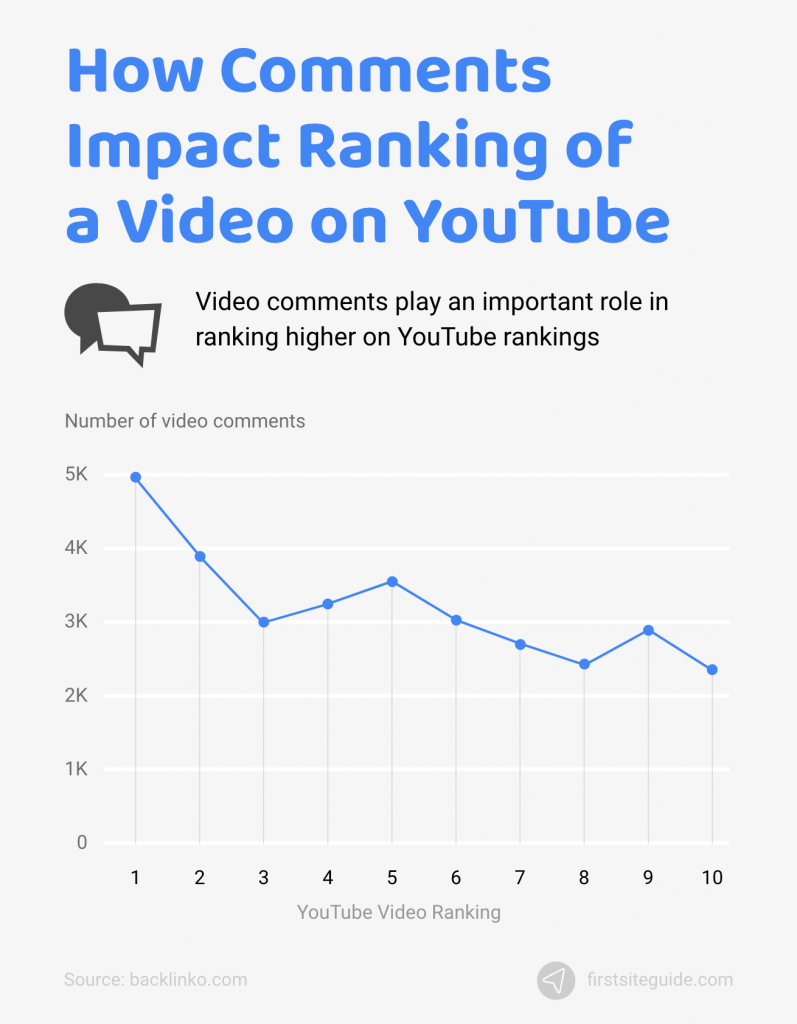
(Source: Backlinko)
49. First page videos on YouTube are an average length of 14 minutes and 50 seconds.
Video length is also an important factor for the YouTube ranking algorithm. Videos on the first page of search results on YouTube are an average length of 14 minutes and 50 seconds.
(Source: Backlinko)
Local SEO statistics
As you might already know, local SEO encompasses various actions to optimize websites to rank better in local searches. It’s one of the primary SEO strategies for businesses that want to deliver an exceptional shopping experience to local consumers. Let’s examine the most important facts and stats regarding local SEO.
50. 30% of all online searches are related to location.
More and more internet users add neighborhood, city area, or city name to their inquiries on search engines. Currently, 30% of all online searches are related to location.
(Source: Google)
51. About 86% of people use online map listings to find the location of a business.
People are still keen on using maps. In fact, 86% of people use map listings to find the location of a business. With the right local SEO strategy, you can be at the top of the local searches related to your business.
(Source: BlueCorona)
52. 78% of people search for something nearby on their smartphones and then visit a store within a day.
Local SEO is more important than you know. 78% of the people who do local searches on their smartphones visit a store the same day. Almost 30% of the local searches result in a purchase.
(Source: Thinkwithgoogle)
53. 88% of consumers trust online reviews.
Online reviews play a vital part in purchasing decisions, especially when it comes to local businesses. 88% of consumers trust online reviews. More importantly, they turn to Google for recommendations and referrals to local businesses.
(Source: Search Engine Land)
54. 93% of consumers used the internet to find a local business in the last year.
Consumers interested in buying a product or service from a local business use the internet to find relevant local businesses. 93% of consumers used the internet to do so in the last year. Surprisingly, 34% of them use the internet to find local businesses every day.
(Source: Brightlocal)
55. The “___ near me today/tonight” mobile searches increased by 900% in the last 2 years.
With more and more people using smartphones every day, it’s logical to see a growth in local mobile searches. Over a two-year period, there was a 900%+ growth in mobile searches for “___ near me today/tonight”.
(Source: Hubspot)
56. 46% of shoppers surveyed confirm inventory online before going to a store.
People don’t want to end up going to a store only to discover that the product they want is sold out. They use the internet to make sure this doesn’t happen. 46% of shoppers surveyed confirm inventory online before going to a store.
(Source: Hubspot)
57. More than 60% of consumers have used local information in ads.
Consumers trust the information displayed in ads. Google found that more than 60% of consumers have used local information in ads. You can leverage this in your ad strategy. The only thing you need to do is to target your ads by location and use location extensions.
(Source: ThinkwithGoogle)
58. Consumers have the most trust in the Better Business Bureau for local business reviews.
Consumers have a lot of options to research local businesses online. They will most likely look at Google My Business for local business reviews. However, they trust the Better Business Bureau the most.
(Source: BrightLocal)
Conclusion
The SEO field is massive, and there’s a lot going on when it comes to best practices. The SEO statistics and facts that we’ve shared with you paint a picture of a brand new world. It’s a world shaped by internet users’ needs, wants, and expectations on one side and major search engines and businesses aiming to rank higher in searches on the other.
These 58 statistics will help you to better understand SEO, the latest trends, and what SEO professionals have been up to lately. Hopefully, we’ve quenched your thirst for statistical SEO knowledge.

Wonderful work on SEO information. I have learned a lot, thanks.
A beautifully written content information about SEO. Learned a lot from this.
Thanks Barbara!